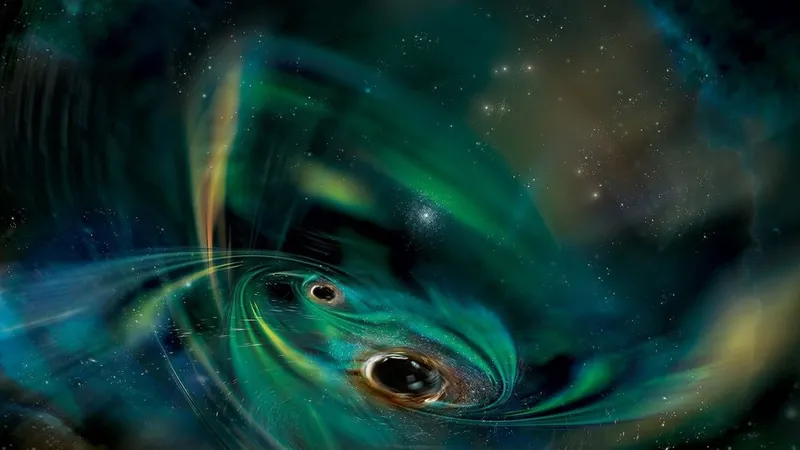
Mysterious Light Bursts from Twin Black Holes Baffle Scientists: Are We on the Brink of Cosmic Discovery?
2024-11-22
Author: Ming
Mysterious Light Bursts from Twin Black Holes Baffle Scientists: Are We on the Brink of Cosmic Discovery?
Astronomers have made an extraordinary discovery: a pair of massive black holes located in a distant galaxy are emitting unusual bursts of light that have baffled researchers. These bright flares, characterized by periodic peaks, are potentially linked to the disruptive interaction between the black holes and a colossal gas cloud—marking a groundbreaking find in the study of cosmic phenomena.
Situated about 1 billion light-years away in the northern constellation Cygnus, this black hole duo resides at the heart of the galaxy known as 2MASX J21240027+3409114. Remarkably close, at just 16 billion miles (or 26 billion kilometers) apart, they complete an orbit every 130 days—a timeframe short enough that light takes merely one day to traverse the distance between them. Over three years, they have consumed around 1.5 to 2 solar masses of gas from the surrounding cloud, and projections suggest they may collide and merge in approximately 70,000 years, according to research published on November 13 in the journal Astronomy & Astrophysics.
The investigation began when, in March 2021, an automated alert system utilizing data from California's Zwicky Transient Facility (ZTF) detected the strange emissions, initially raising suspicions of a supernova due to the sudden glow. However, the appearance of additional outbursts in 2022 prompted further scrutiny by the research team.
Following detailed analysis, the event was later identified as an active galactic nucleus (AGN), which refers to a black hole drawing material from a surrounding accretion disk. However, spectral data collected from various observatories across Mexico, India, and Spain revealed an unusual M-shaped pattern in the results, occurring every two to three months—an inconsistency unexplainable by either a supernova or an AGN.
Lorena Hernández-García, lead author of the study and an astrophysicist at the Millennium Institute of Astrophysics in Chile, expressed her fascination: "This is very different from anything I have seen before." Her team detected the same M-shaped spectral pattern in both X-ray and ultraviolet wavelengths later that year, prompting a realization of the finding's significance. "I'm looking at the light curve more or less every day to see what's happening," she noted.
While the data does not currently indicate characteristics typical of a tidal disruption event (TDE)—where a star is ripped apart by a black hole's gravitational forces—the prevailing hypothesis suggests the gas cloud is on a perpendicular trajectory to the orbit of the twin black holes. Consequently, this gigantic cloud, larger than the binary black hole system, might be getting shredded by the black holes’ powerful gravity, causing the observed M-shaped light emissions linked to pieces of gas ejected into space during their encounter.
Nonetheless, Hernández-García has not dismissed the possibility that a new type of partial TDE could be occurring in this galaxy. The ongoing merger of this galaxy with another to its south, approximately 29,000 light-years away, may also be contributing to the formation of significant amounts of dust and gas.
Astronomers believe that gas clouds like the one identified could be quite common in many merging galaxies that host binary black holes; however, none have been previously detected. Hernández-García attributes the lack of past discoveries to limitations in the instrumentation available until recent advancements. Since the ZTF became operational in 2018, she remarked, "We are finding a lot of weird stuff that wasn’t possible to see before."
As our understanding of black holes continues to evolve, this extraordinary find may herald a new era of astrophysical research, leaving scientists eager to explore the complexities of the universe and the secrets it holds. Keep your telescopes ready—who knows what other cosmic wonders might be waiting to be uncovered?



 Brasil (PT)
Brasil (PT)
 Canada (EN)
Canada (EN)
 Chile (ES)
Chile (ES)
 España (ES)
España (ES)
 France (FR)
France (FR)
 Hong Kong (EN)
Hong Kong (EN)
 Italia (IT)
Italia (IT)
 日本 (JA)
日本 (JA)
 Magyarország (HU)
Magyarország (HU)
 Norge (NO)
Norge (NO)
 Polska (PL)
Polska (PL)
 Schweiz (DE)
Schweiz (DE)
 Singapore (EN)
Singapore (EN)
 Sverige (SV)
Sverige (SV)
 Suomi (FI)
Suomi (FI)
 Türkiye (TR)
Türkiye (TR)